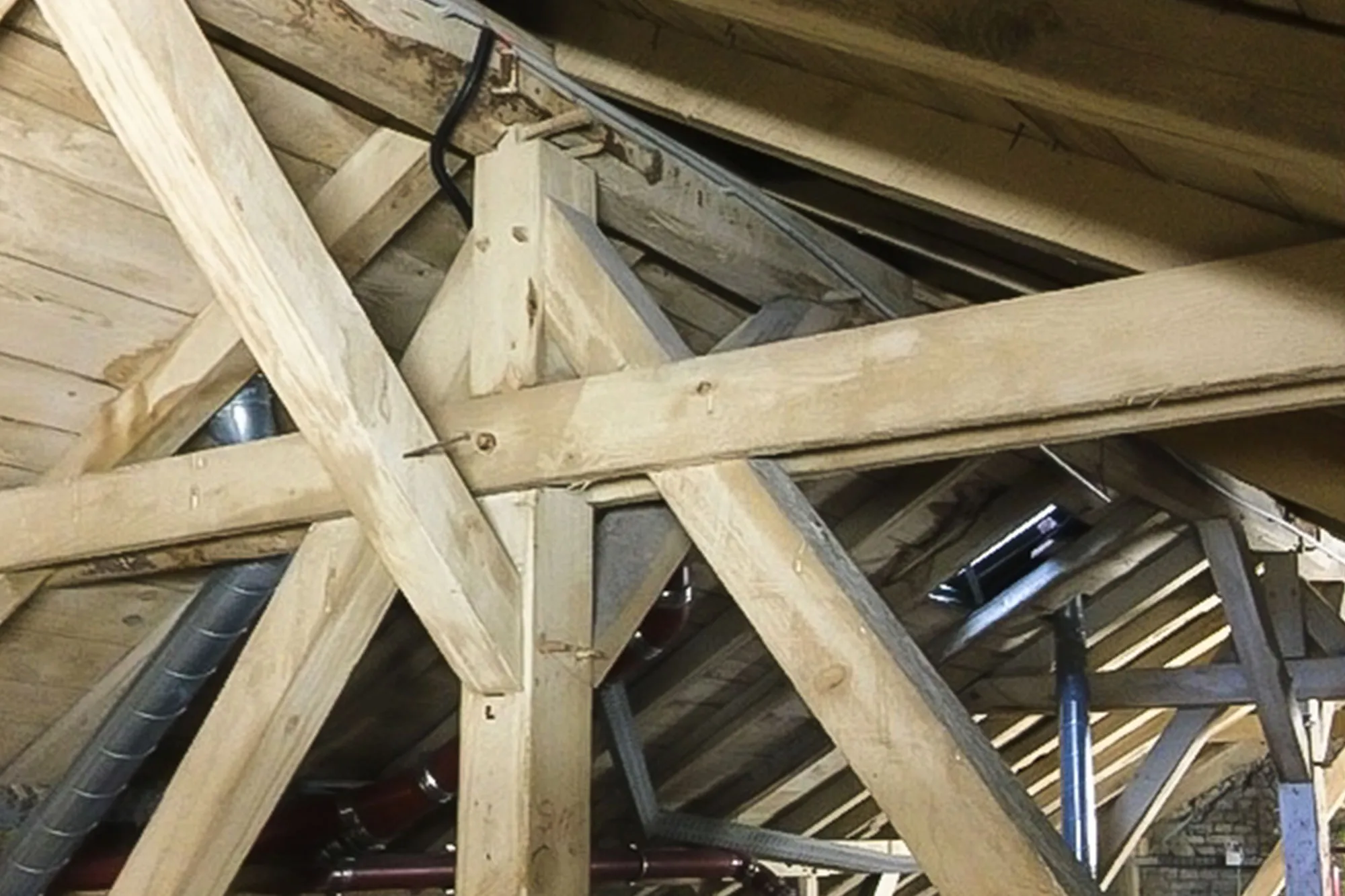Refurbishment of an Attic Storey – Bundeswehr Hospital House 1.4
Static calculation and creation and application of a guideline for dealing with harmful substances in existing timber constructions

Motivation
The topic of contaminated sites in timber construction is complex. This is because there are different guidelines for different pollutants, which are not all structured in the same way and answer a different number of detailed questions. This topic was to be analysed as part of this work. In the course of the refurbishment of the Bundeswehr Hospital House 1.4, a guideline was created to facilitate the handling of harmful substances in timber construction and to point out the most important guidelines to the reader. The static calculations and all building physics considerations were based on the renovation plans, which were planned for reasons of historical preservation.
Processing
The following is included in the elaboration: the preparation of the static calculation of the roof truss, its explanations and justifications for decisions regarding the type of execution, as well as the associated implementation plans. A thermal insulation certificate and a fire resistance certificate were also prepared. In addition, the above-mentioned guideline for dealing with harmful substances in timber construction was drawn up. This is summarised below. The refurbishment of the listed building relates to the restoration of the original roof covering. This was never supported by the roof truss in its current form. In the course of this, the damaged roof boarding and roofing felt will be removed and the rafter system completely renewed. The new rafter layer, the purlins, the studs, the sleepers and the ceiling beams must be statically verified and, if necessary, reinforced. In addition, the ceiling disc level is being constructed and verified. In addition to replacing the rafter layer, an alternative calculation for reinforcing the inadequate rafters was calculated and discussed. Furthermore, in addition to the reinforcements of the sleepers, alternative calculations for the replacement of the inadequate sleepers were prepared and discussed. In addition, the sleepers were calculated as a framework in conjunction with the ceiling beams serving as supports in order to take into account the spring effect of the ceiling beams.
Pollutants in timber construction
The analysis of pollutants in timber construction includes chemical wood preservatives and other pollutants that can occur in timber structures. The collection of information on pollutants includes general information, use and occurrence, health hazards and remediation methods as well as occupational safety and disposal methods. Only the most important information is briefly listed below.
The following pollutants are covered:
Pentachlorophenol has been used as a fungicide since the 1940s. Among other things, it is carcinogenic. The substance is particularly common in wooden components of buildings from the 1960s–80s. Due to its slow evaporation, the substance can be detected in the contaminated room for a very long time. Remediation is carried out by coating, spatial separation or removal of both primary and secondary sources. Attention must be paid to protective equipment and adequate disposal.
Lindane is mainly found in buildings from the 1940s–80s. Among other things, it is neurotoxic and was used as an insecticide. Like PCP, it is slowly volatile. It was often used in combination with PCP. Remediation can be achieved in the same way as with PCP.
Dichlorodiphenyltrichloroethane is an insecticide and can be found in buildings until the early 1970s. The active substance was not banned in the GDR until 1989. DDT is persistent and can therefore release harmful vapours over a long period of time. Among other things, it is harmful to the liver and neurotoxic. As with lindane, it is advisable to follow the PCP guideline for remediation.
Tributyltin oxide is a fungicide and is mainly found in buildings from the 1980s. Among other things, it is toxic and dangerous for humans and the environment. It can be shielded from the room air by means of renovation coatings or panelling made of plasterboard, for example. Removal is also possible.
Endosulfan is an insecticide that can be found in buildings from the 1950s to the 2000s. It is highly toxic. Particular attention must be paid to occupational safety during remediation. Substances contaminated by endosulfan must either be removed or shielded from the room air.
Chloronaphthalene was used from the 1920s until the 1980s both as an insecticide and as a fungicide in timber construction. It is primarily very odour-tainting. Removal is often necessary during renovation.
Polycyclic aromatic hydrocarbon is an active substance that was contained in carbolineum, for example. This was used as a wood preservative from the 19th century until the early 1990s. Tar paper also contains PAHs. Among other things, they are carcinogenic and damage the human organism. Damaged components are remediated by removing them.
Polychlorinated biphenyls were used from the 1950s until the early 1980s. It can be found in plasticisers, sealants and other substances. Among other things, it is carcinogenic and harmful to fertility. For remediation, spatial separation or removal is recommended.
Formaldehyde can be found in glues and binding agents, for example. It is carcinogenic and harmful to the eyes and mucous membranes. The removal of contaminated components is recommended.
A distinction is made between weakly and firmly bound asbestos products, with weakly bound asbestos being considered more critical. Until the 1990s, asbestos was used in fire protection, seals and many other applications. It is toxic, carcinogenic and harmful to the respiratory tract. The urgency of remediation is categorised into three levels. Remediation may involve spatial separation or removal.
Artificial mineral fibres can be found in many thermal and sound insulation products. CMFs are harmful to the skin, eyes and mucous membranes. Spatial separation or removal is possible here.
Wood-destroying fungi can be found both in wooden components and in neighbouring components such as masonry. They can cause allergic reactions, headaches and nausea. Removal of the affected components is necessary.
Project participants
1st Assessor
2nd Assessor
Dr. Hermann Babilon
Master's graduate
David Klautke
